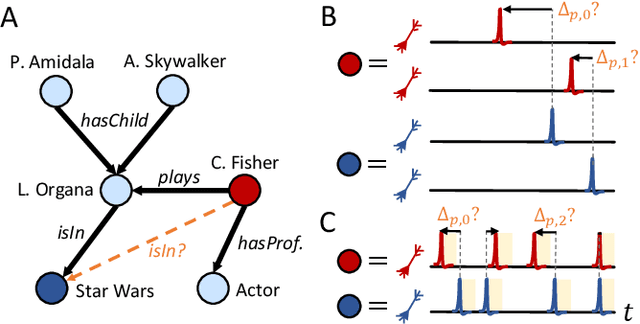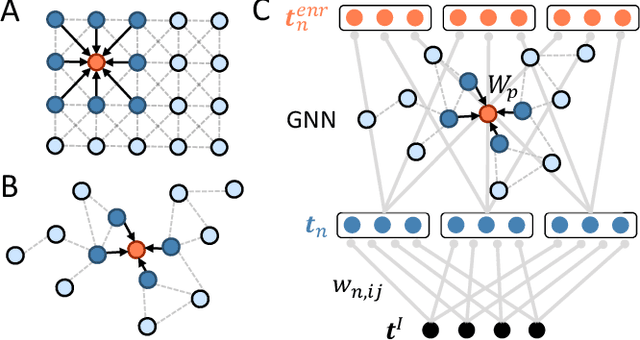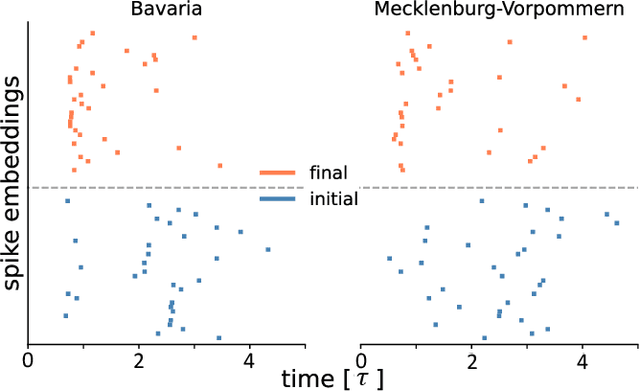Josep Soler Garrido
Neuro-symbolic computing with spiking neural networks
Aug 04, 2022


Abstract:Knowledge graphs are an expressive and widely used data structure due to their ability to integrate data from different domains in a sensible and machine-readable way. Thus, they can be used to model a variety of systems such as molecules and social networks. However, it still remains an open question how symbolic reasoning could be realized in spiking systems and, therefore, how spiking neural networks could be applied to such graph data. Here, we extend previous work on spike-based graph algorithms by demonstrating how symbolic and multi-relational information can be encoded using spiking neurons, allowing reasoning over symbolic structures like knowledge graphs with spiking neural networks. The introduced framework is enabled by combining the graph embedding paradigm and the recent progress in training spiking neural networks using error backpropagation. The presented methods are applicable to a variety of spiking neuron models and can be trained end-to-end in combination with other differentiable network architectures, which we demonstrate by implementing a spiking relational graph neural network.
An energy-based model for neuro-symbolic reasoning on knowledge graphs
Oct 04, 2021



Abstract:Machine learning on graph-structured data has recently become a major topic in industry and research, finding many exciting applications such as recommender systems and automated theorem proving. We propose an energy-based graph embedding algorithm to characterize industrial automation systems, integrating knowledge from different domains like industrial automation, communications and cybersecurity. By combining knowledge from multiple domains, the learned model is capable of making context-aware predictions regarding novel system events and can be used to evaluate the severity of anomalies that might be indicative of, e.g., cybersecurity breaches. The presented model is mappable to a biologically-inspired neural architecture, serving as a first bridge between graph embedding methods and neuromorphic computing - uncovering a promising edge application for this upcoming technology.
Machine learning on knowledge graphs for context-aware security monitoring
May 18, 2021



Abstract:Machine learning techniques are gaining attention in the context of intrusion detection due to the increasing amounts of data generated by monitoring tools, as well as the sophistication displayed by attackers in hiding their activity. However, existing methods often exhibit important limitations in terms of the quantity and relevance of the generated alerts. Recently, knowledge graphs are finding application in the cybersecurity domain, showing the potential to alleviate some of these drawbacks thanks to their ability to seamlessly integrate data from multiple domains using human-understandable vocabularies. We discuss the application of machine learning on knowledge graphs for intrusion detection and experimentally evaluate a link-prediction method for scoring anomalous activity in industrial systems. After initial unsupervised training, the proposed method is shown to produce intuitively well-calibrated and interpretable alerts in a diverse range of scenarios, hinting at the potential benefits of relational machine learning on knowledge graphs for intrusion detection purposes.
SpikE: spike-based embeddings for multi-relational graph data
May 17, 2021



Abstract:Despite the recent success of reconciling spike-based coding with the error backpropagation algorithm, spiking neural networks are still mostly applied to tasks stemming from sensory processing, operating on traditional data structures like visual or auditory data. A rich data representation that finds wide application in industry and research is the so-called knowledge graph - a graph-based structure where entities are depicted as nodes and relations between them as edges. Complex systems like molecules, social networks and industrial factory systems can be described using the common language of knowledge graphs, allowing the usage of graph embedding algorithms to make context-aware predictions in these information-packed environments. We propose a spike-based algorithm where nodes in a graph are represented by single spike times of neuron populations and relations as spike time differences between populations. Learning such spike-based embeddings only requires knowledge about spike times and spike time differences, compatible with recently proposed frameworks for training spiking neural networks. The presented model is easily mapped to current neuromorphic hardware systems and thereby moves inference on knowledge graphs into a domain where these architectures thrive, unlocking a promising industrial application area for this technology.
 Add to Chrome
Add to Chrome Add to Firefox
Add to Firefox Add to Edge
Add to Edge